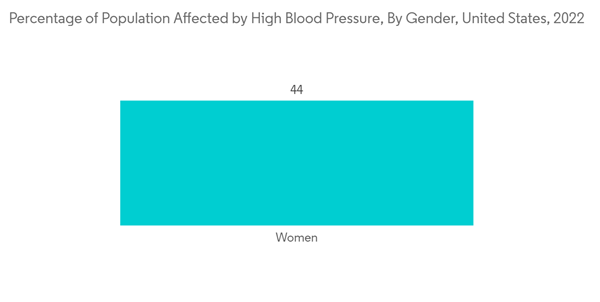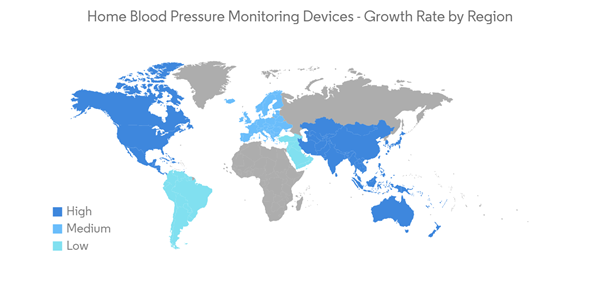The COVID-19 pandemic had a notable impact on the growth of the market due to the imposition of strict lockdown regulations in the initial stages of the pandemic. This resulted in the rising adoption of home blood pressure monitoring due to the increasing usage of telehealth services during the pandemic. For instance, an article published in the Journal of Comprehensive Clinical Medicine in March 2021 indicated that the use of home blood pressure tracking when paired with digital health technology facilitated remote telemonitoring of self-measured blood pressure values. The utilization of home blood pressure monitoring devices increased significantly during the COVID-19 pandemic. These factors had a significant impact on the growth of the market during the pandemic period. Also, the demand for home blood pressure monitoring devices is expected to remain intact during the post-pandemic period, thereby contributing to the growth of the market over the forecast period.
The major factor attributing to the growth of the market is the increase in the incidence of blood pressure-related diseases like heart attacks, cardiovascular diseases, aneurysms, and metabolic syndrome. According to the World Health Organization's key facts on hypertension published in August 2021, around 1.28 million people around the world in the age group of 30-79 years are affected by hypertension, with over two-thirds of them living in low- and middle-income countries. Such a high prevalence of hypertension among the global population is expected to drive the demand for home blood pressure monitoring devices. Also, the rise in cardiovascular diseases is expected to increase the demand for home blood pressure monitoring devices. For instance, the British Heart Foundation (BHF) data published in January 2022 reported that the most common heart conditions affected globally were coronary (ischemic) heart disease (global prevalence estimated at 200 million), peripheral arterial (vascular) disease (110 million), stroke (100 million), and atrial fibrillation (60 million). The report also mentioned that the prevalence of heart and circulatory diseases in North America was 46 million, in Europe it was 99 million, in Africa it was 58 million, in South America it was 32 million, and in Asia and Australia it was 310 million. Thus, the high incidence of various cardiovascular diseases among the global population is expected to contribute to the growth of the market.
Additionally, the increasing product developments by various key market players are expected to contribute to the growth of the market. For instance, in October 2022, Omron Healthcare developed a portfolio of blood pressure monitors by converting them into connected devices for ease of usage at home. This major update to the portfolio will help users and medical professionals manage hypertension in a way that is smooth, easy, and accurate.
However, the cost of the devices and their accuracy are expected to restrain the growth of the market over the forecast period.
Home Blood Pressure Monitoring Devices Market Trends
Wrist Monitors Segment is Dominating the Home Blood Pressure Monitoring Devices Market
The wrist monitor segment is expected to hold a major share of the market due to the rising preference of patients for convenient observing of blood pressure, thus providing growth opportunities for the target market. The wrist monitors are simple and less bulky. Though they are less familiar than the upper arm monitors, they have become more popular due to their portability. They have all the same components and features as the upper-arm monitors, except they are smaller. Wrist cuffs are also ideal for people with arm or hand mobility limitations or those with larger upper arms; the wrist monitor can be a more comfortable and easier-to-use alternative.The increasing incidence of blood pressure-related diseases such as heart stroke is expected to drive the demand for wrist monitors, thereby contributing to the growth of the studied segment. For instance, the NCBI article published in March 2021 mentioned that the overall incidence of heart stroke in Asian countries varied between 116 and 483 per 100,000 persons. Moreover, the growing usage of home blood pressure monitors, the advancements in the devices, and the active promotions regarding the devices are boosting the segment's growth.
Also, product launches by the key market players are expected to boost the market's growth. For instance, in May 2021, Biobeat, a wearable remote patient monitoring solutions provider for healthcare, launched its new wearable and continuous ambulatory blood pressure monitoring (ABPM) chest-monitoring device. Such product launches are projected to significantly fuel the growth of the studied segment over the forecast period.
North America is Expected to Hold Significant Share in the Market Over the Forecast Period
North America is expected to hold a significant market share in the overall market throughout the forecast period. The regional growth is due to factors such as the presence of key players, the high number of people with hypertension, and the established healthcare infrastructure.According to CDC data on hypertension updated in July 2022, around 116 million people had high blood pressure in the United States in 2021. The same report also mentioned that in 2021, around 37 million adults in the United States will have uncontrolled hypertension. Also, as per the WHO report in August 2021, the prevalence of hypertension among the Canadian female population was 20% and the male population was 24% in 2021. Furthermore, beneficial government initiatives and an increase in the number of research partnerships are some of the drivers expected to increase market growth. For example, the CDC's Million Hearts initiative, launched in February 2022, aims to prevent 1 million heart attacks and strokes within five years, by 2027.Such initiatives are expected to drive the demand for home blood pressure monitoring devices, thereby contributing to the growth of the market in this region.
Also, innovative product launches in the region are expected to aid the market's growth. For instance, in January 2022, Aktiia, a continuous blood pressure monitoring solutions provider, launched its 24/7 Blood Pressure Monitor in the United States, thereby delivering the next generation of clinical wearables specifically designed to meet the needs of both patients and physicians.
Home Blood Pressure Monitoring Devices Industry Overview
The home blood pressure monitoring device market is moderately competitive and consists of several major players. Some of the companies that are currently dominating the market are American Diagnostic Corporation, Halma plc, A&D Medical, Beurer GmbH, Omron Healthcare, Inc., Qardio, Inc., Spengler SAS, Rossmax International Ltd., Welch Allyn, Inc., and Koninklijke Philips N.V.Additional Benefits:
- The market estimate (ME) sheet in Excel format
- 3 months of analyst support
This product will be delivered within 2 business days.
Table of Contents
Companies Mentioned (Partial List)
A selection of companies mentioned in this report includes, but is not limited to:
- American Diagnostic Corporation
- Halma plc
- A&D Medical
- Beurer GmbH
- Omron Healthcare, Inc.
- Qardio, Inc.
- Spengler SAS
- Rossmax International Ltd.
- Welch Allyn, Inc.
- Koninklijke Philips N.V.
- GE Healthcare
- Contec Medical










